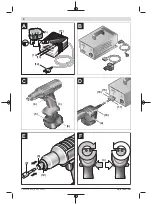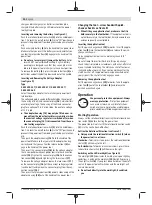
16
| English
u
Use power tools only with specifically designated bat-
tery packs.
Use of any other battery packs may create a
risk of injury and fire.
u
When battery pack is not in use, keep it away from
other metal objects, like paper clips, coins, keys,
nails, screws or other small metal objects, that can
make a connection from one terminal to another.
Shorting the battery terminals together may cause burns
or a fire.
u
Under abusive conditions, liquid may be ejected from
the battery; avoid contact. If contact accidentally oc-
curs, flush with water. If liquid contacts eyes, addi-
tionally seek medical help.
Liquid ejected from the bat-
tery may cause irritation or burns.
u
Do not use a battery pack or tool that is damaged or
modified.
Damaged or modified batteries may exhibit
unpredictable behaviour resulting in fire, explosion or risk
of injury.
u
Do not expose a battery pack or tool to fire or excess-
ive temperature.
Exposure to fire or temperature above
130°C may cause explosion.
u
Follow all charging instructions and do not charge the
battery pack or tool outside the temperature range
specified in the instructions.
Charging improperly or at
temperatures outside the specified range may damage
the battery and increase the risk of fire.
Service
u
Have your power tool serviced by a qualified repair
person using only identical replacement parts.
This
will ensure that the safety of the power tool is maintained.
u
Never service damaged battery packs.
Service of bat-
tery packs should only be performed by the manufacturer
or authorized service providers.
Safety Warnings for Screwdrivers
u
Hold the power tool by insulated gripping surfaces,
when performing an operation where the fastener
may contact hidden wiring.
Fasteners contacting a "live"
wire may make exposed metal parts of the power tool
"live" and could give the operator an electric shock.
u
Use suitable detectors to determine if there are hid-
den supply lines or contact the local utility company
for assistance.
Contact with electric cables can cause
fire and electric shock. Damaging gas lines can lead to ex-
plosion. Breaking water pipes causes property damage.
u
Hold the power tool securely.
When tightening and
loosening screws be prepared for temporarily high torque
reactions.
u
Secure the workpiece.
A workpiece clamped with
clamping devices or in a vice is held more secure than by
hand.
u
Always wait until the power tool has come to a com-
plete stop before placing it down.
The application tool
can jam and cause you to lose control of the power tool.
u
In case of damage and improper use of the battery, va-
pours may be emitted. The battery can set alight or ex-
plode.
Ensure the area is well ventilated and seek medical
attention should you experience any adverse effects. The
vapours may irritate the respiratory system.
u
Do not open the battery.
There is a risk of short-circuit-
ing.
u
The battery can be damaged by pointed objects such
as nails or screwdrivers or by force applied externally.
An internal short circuit may occur, causing the battery to
burn, smoke, explode or overheat.
u
Only use the battery with products from the manufac-
turer.
This is the only way in which you can protect the
battery against dangerous overload.
Protect the battery against heat, e.g.
against continuous intense sunlight, fire,
water and moisture.
There is a risk of explo-
sion.
u
Switch the power tool off immediately if the applica-
tion tool becomes blocked. Be prepared for high
torque reactions which cause kickback.
The applica-
tion tool becomes blocked when it becomes jammed in
the workpiece or when the power tool becomes over-
loaded.
WARNING
The dust produced by sanding,
sawing, grinding, drilling and
other similar activities may cause cancer, congenital de-
fects or genetic mutations
. Some of these dusts contain
substances such as:
Lead in lead-based paint and varnish; crystalline silica in
bricks, cement and other building materials; arsenic and
chromate in chemically treated wood. The risk of becoming
ill depends on how frequently you are exposed to these sub-
stances. To reduce the potential danger, you should always
wear adequate personal protective equipment (e.g. specially
made breathing apparatus that can filter out even the smal-
lest of dust particles) and work only in well-ventilated areas.
u
Avoid switching on the tool accidentally. Make sure
that the on/off switch is set to the off position before
inserting a battery.
Accidents can occur as a result of
carrying the power tool with your finger on the on/off
switch or inserting the battery while the power tool is
switched on.
u
Do not use application tools that are worn or in other-
wise less than perfect condition.
Defective application
tools can break, for example, causing material damage
and personal injury.
u
When fitting an application tool, make sure that it is
held securely in the tool holder.
If the application tool is
not held securely in the tool holder, it may become loose
and consequently uncontrollable.
u
Be careful when screwing in long screws – there is a
risk of slipping when using particular screws and ap-
plication tools.
Long screws are often difficult to control
and there is a danger that you will slip and hurt yourself
when screwing them in.
u
Check which rotational direction is set before switch-
ing on the power tool.
If you want to loosen a screw but
the rotational direction is set to tighten the screw, for ex-
1 609 92A 4V3 | (14.02.2019)
Bosch Power Tools
Summary of Contents for 0 602 490 431
Page 3: ... 3 10 9 8 7 6 3 4 5 23 1 2 Bosch Power Tools 1 609 92A 4V3 14 02 2019 ...
Page 5: ... 5 I 20 6 G H 22 21 21 10 19 8 21 Bosch Power Tools 1 609 92A 4V3 14 02 2019 ...
Page 332: ...332 آفارسی 1 609 92A 4V3 14 02 2019 Bosch Power Tools ...
Page 334: ...334 1 609 92A 4V3 14 02 2019 Bosch Power Tools ...
















































